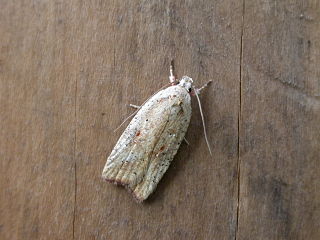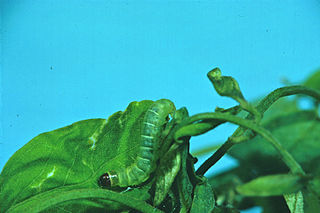
Oecophoridae is a family of small moths in the superfamily Gelechioidea. The phylogeny and systematics of gelechoid moths are still not fully resolved, and the circumscription of the Oecophoridae is strongly affected by this.

The gorse tip moth is a smallish moth species of the family Depressariidae.

Agonopterix robiniella, the four-dotted agonopterix moth or locust leaf roller, is a moth of the family Depressariidae. It is found in North America, where it has been recorded from Nova Scotia to Georgia, west to Oklahoma, north to Illinois, Michigan and southern Ontario.

The Depressariinae – sometimes spelled "Depressiinae" in error – are a subfamily of moths in the superfamily Gelechioidea. Like their relatives therein, their exact relationships are not yet very well resolved. It has been considered part of family Elachistidae sensu lato or included in an expanded Oecophoridae. In modern classifications they are treated as the distinct gelechioid family Depressariidae.

Agonopterix is a moth genus of the superfamily Gelechioidea. It is placed in the family Depressariidae, which was often – particularly in older treatments – considered a subfamily of the Oecophoridae or included in the Elachistidae.
Agonopterix arnicella is a moth in the Depressariidae family. It was described by Walsingham in 1881. It is found in North America, where it has been recorded from Alberta, Ontario, Washington, Oregon and California.
Agonopterix lythrella is a moth in the Depressariidae family. It was described by Walsingham in 1889. It is found in North America, where it has been recorded from Illinois, Maine, Maryland, Massachusetts, Michigan, Minnesota, New Brunswick, New Hampshire, New York, North Carolina, Nova Scotia, Ohio, Ontario and Saskatchewan.
Agonopterix gelidella is a moth in the Depressariidae family. It was described by August Busck in 1908. It is found in North America, where it has been recorded from Alberta, Maine, Manitoba and North Carolina.
Agonopterix muricolorella is a moth in the Depressariidae family. It was described by August Busck in 1902. It is found in North America, where it has been recorded from Colorado, eastern Oregon and eastern Washington.
Agonopterix rosaciliella is a moth in the Depressariidae family. It was described by August Busck in 1904. It is found in North America, where it has been recorded from Alaska and western Saskatchewan through Washington to California and Arizona.
Agonopterix senicionella is a moth in the Depressariidae family. It was described by August Busck in 1902. It is found in North America, where it has been recorded from Kentucky, Michigan, Ohio, Virginia and West Virginia.
Agonopterix walsinghamella, or Walsingham's agonopterix moth, is a moth in the Depressariidae family. It was described by August Busck in 1902. It is found in North America, where it has been recorded from the north-eastern United States and Canada.
Agonopterix clarkei is a moth in the Depressariidae family. It was described by Keifer in 1936. It is found in North America, where it has been recorded from California, Washington and Manitoba.
Agonopterix cratia is a moth in the family Depressariidae. It was described by Ronald W. Hodges in 1974. It is found in North America, where it has been recorded from Arizona and New Mexico.
Agonopterix curvilineella, the curved-line agonopterix moth, is a moth in the Depressariidae family. It was described by William Beutenmüller in 1889. It is found in North America, where it has been recorded from Illinois, Indiana, Kentucky, Maine, Maryland, Massachusetts, Michigan, Minnesota, Mississippi, New Brunswick, New York, Ohio, Ontario, Quebec, Tennessee, West Virginia and Wisconsin.
Agonopterix hesphoea is a moth in the family Depressariidae. It was described by Ronald W. Hodges in 1975. It is found in North America, where it has been recorded from Texas.
Agonopterix latipalpella is a moth in the Depressariidae family. It was described by William Barnes and August Busck in 1920. It is found in North America, where it has been recorded from Texas.
Agonopterix toega is a moth in the family Depressariidae. It was described by Ronald W. Hodges in 1974. It is found in North America, where it has been recorded from California.
Himmacia stratia is a moth in the family Depressariidae. It was described by Ronald W. Hodges in 1974. It is found in North America, where it has been recorded from Arizona.
Ronald William Hodges, known as Ron, was an American entomologist and lepidopterist.






